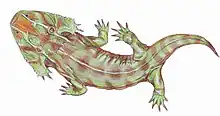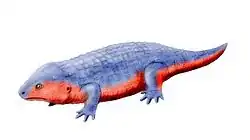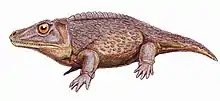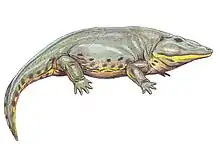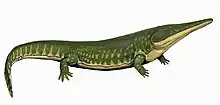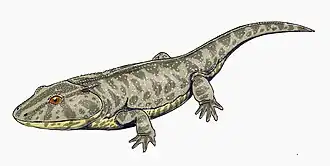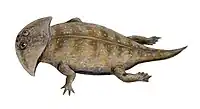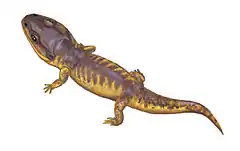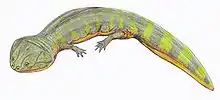Acheloma
Acheloma (also known as Trematops milleri) is an extinct genus of temnospondyl that lived during the Early Permian.[1] The type species is A. cumminsi.
| Acheloma Temporal range: Early Permian, | |
|---|---|
 | |
| Skeletal mount of A. cumminsi, Field Museum of Natural History | |
| Scientific classification | |
| Domain: | Eukaryota |
| Kingdom: | Animalia |
| Phylum: | Chordata |
| Class: | Amphibia |
| Order: | †Temnospondyli |
| Family: | †Trematopidae |
| Genus: | †Acheloma Cope, 1882 |
| Species | |
| |
| Synonyms | |
|
Trematops milleri Williston, 1909 Trematops thomasi Mehl, 1926 Trematops willistoni Olson, 1941 Trematops stonei Williston, 1970 | |

History of study
Acheloma was named by Edward Drinker Cope in 1882 based on a partial skull with associated postcranial elements from the Arroyo Formation of Texas;[2] the specimen is currently reposited at the American Museum of Natural History in New York. Subsequent discoveries of large trematopids from the Arroyo Formation were named as different species of Trematops (T. milleri, T. willistoni), but these have since been synonymized with Acheloma cumminsi. Trematops stonei from the Washington Formation of Ohio and Trematops thomasi from Oklahoma have also been synonymized with A. cumminsi. A second species of Acheloma was described by Polley & Reisz (2011) from the Richards Spur locality in Oklahoma.[3]
Anatomy
Schoch & Milner (2014) provide nine characters in their diagnosis of Acheloma: (1) toothed crest on the vomer extending medial to the internal naris; (2) constricted otic notch with nearly horizontal ventral margin; (3) preorbital region twice as long as the skull table; (4) naris twice as long as the orbit; (5) posterior skull table wide and posterolaterally expanded; (6) skull margin widens at level of and posterior to orbit; (7) palatine and ectopterygoid with tall fangs; (8) large intervomerine fenestra; and (9) choana elongate and curved with a Y-shaped contour.[4] Acheloma cumminsi and A. dunni are distinguished by the purported absence of lateral exposures of the palatine (LEP) and the ectopterygoid (LEE) in A. cumminsi,[3] but these exposures were subsequently identified following re-examination of the holotype of this taxon.[5]
Ecology
Various analyses have confirmed hypotheses that Acheloma was a terrestrial temnospondyl.[6][7]
Phylogeny
The following cladogram shows the phylogenetic position of Acheloma, from Polley & Reisz, 2011.[3]
| Dissorophoidea |
| |||||||||||||||||||||||||||||||||||||||||||||||||||||||||||||||
References
- Reisz, Robert; Dilkes, David William (1987). "Trematops milleri Williston, 1909, identified as a junior synonym of Acheloma cumminsi Cope, 1882 : with a revision of the genus". American Museum Novitates (2902): 1–12. hdl:2246/5185.
- Cope, E. D. (1882). "Third Contribution to the History of the Vertebrata of the Permian Formation of Texas". Proceedings of the American Philosophical Society. 20 (112): 447–461. ISSN 0003-049X. JSTOR 982692.
- Polley, B.P.; and Reisz, R.R. (2011). "A new Lower Permian trematopid (Temnospondyli: Dissorophoidea) from Richards Spur, Oklahoma". Zoological Journal of the Linnean Society. 161 (4): 789–815. doi:10.1111/j.1096-3642.2010.00668.x.
- Schoch, Rainer R.; Milner, Andrew R. (2014). Sues, Hans-Dieter (ed.). Handbuch der Paläoherpetologie Part 3A2. Temnospondyli I. Stuttgart: Verlag Dr. Friedrich Pfeil. ISBN 9783931516260. OCLC 580976.
- Gee, Bryan M.; Bevitt, Joseph J.; Reisz, Robert R. (2019-03-12). "A Juvenile Specimen of the Trematopid Acheloma From Richards Spur, Oklahoma and Challenges of Trematopid Ontogeny". Frontiers in Earth Science. 7: 38. Bibcode:2019FrEaS...7...38G. doi:10.3389/feart.2019.00038. ISSN 2296-6463.
- Sanchez, S.; Germain, D.; De Ricqlès, A.; Abourachid, A.; Goussard, F.; Tafforeau, P. (2010). "Limb-bone histology of temnospondyls: implications for understanding the diversification of palaeoecologies and patterns of locomotion of Permo-Triassic tetrapods: Diversification of early tetrapod locomotion". Journal of Evolutionary Biology. 23 (10): 2076–2090. doi:10.1111/j.1420-9101.2010.02081.x. PMID 20840306.
- Quemeneur, Sonia; de Buffrénil, Vivian; Laurin, Michel (2013). "Microanatomy of the amniote femur and inference of lifestyle in limbed vertebrates: Femoral Microanatomy and Lifestyle". Biological Journal of the Linnean Society. 109 (3): 644–655. doi:10.1111/bij.12066.


